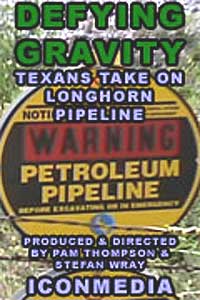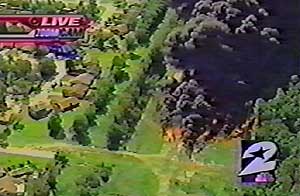DEFYING GRAVITY

Texans Take On Longhorn Pipeline
by Iconmedia
A new video documentary about the Longhorn Pipeline in Texas.
Saturday, February 15, 4:30 p.m., Alamo Drafthouse, Austin, TX
Video documentary premiere screening followed by Longhorn Pipeline update.
DATE: Saturday, February 15, 2003
TIME: 4:30 p.m.
THEATER: Alamo Drafthouse Cinema, 409 B Colorado St, Austin, TX
COST: $6.00
ALAMO DRAFTHOUSE: www.alamodrafthouse.com
|
 In DEFYING GRAVITY, Texans from El Paso to Houston reveal the dangers of the
Longhorn Pipeline. The new owners of the old Exxon crude oil line plan to
pump gasoline through urban neighborhoods and across sensitive watersheds in
a pipe known to leak and spill.
DEFYING GRAVITY features Texas ranchers,
homeowners, lawyers, environmentalists, and experts opposed to the
conversion of this 52-year-old pipeline from one that until 1995 carried
crude oil downhill to Houston to one that will carry gasoline, jet fuel, and
diesel to El Paso.
What is the Longhorn Pipeline?
The Longhorn Pipeline is a petroleum pipeline that was built in 1950 to carry crude oil 450 miles from Crane, Texas to Houston refineries. The Longhorn Parters Pipeline Co. (Exxon Mobil, BP Amoco, Chisholm Holdings, affiliates of the Beacon Energy Fund, and Williams Pipe Line Company, and others) bought the pipeline from Exxon in 1995, and it has been dormant ever since.
Longhorn Partners Pipeline, Co. is extending the line 250 additional miles from Crane to El Paso and plans to pump refined fuels, including gasoline, diesel, and aviation fuel the 700 miles from Houston to El Paso.
Why is there such a concern over this pipeline?
The areas that the pipeline runs through have changed significantly since the pipeline was built in 1950. It would carry up to 225,000 barrels of fuel a day through densely populated neighborhoods in Houston and Austin, near schools, through parks, as well as through creeks, rivers, and water supplies, including the environmentally sensitive Edwards Aquifer.
Other reasons to be concerned:
In DEFYING GRAVITY, Texans from El Paso to Houston reveal the dangers of the
Longhorn Pipeline. The new owners of the old Exxon crude oil line plan to
pump gasoline through urban neighborhoods and across sensitive watersheds in
a pipe known to leak and spill.
DEFYING GRAVITY features Texas ranchers,
homeowners, lawyers, environmentalists, and experts opposed to the
conversion of this 52-year-old pipeline from one that until 1995 carried
crude oil downhill to Houston to one that will carry gasoline, jet fuel, and
diesel to El Paso.
What is the Longhorn Pipeline?
The Longhorn Pipeline is a petroleum pipeline that was built in 1950 to carry crude oil 450 miles from Crane, Texas to Houston refineries. The Longhorn Parters Pipeline Co. (Exxon Mobil, BP Amoco, Chisholm Holdings, affiliates of the Beacon Energy Fund, and Williams Pipe Line Company, and others) bought the pipeline from Exxon in 1995, and it has been dormant ever since.
Longhorn Partners Pipeline, Co. is extending the line 250 additional miles from Crane to El Paso and plans to pump refined fuels, including gasoline, diesel, and aviation fuel the 700 miles from Houston to El Paso.
Why is there such a concern over this pipeline?
The areas that the pipeline runs through have changed significantly since the pipeline was built in 1950. It would carry up to 225,000 barrels of fuel a day through densely populated neighborhoods in Houston and Austin, near schools, through parks, as well as through creeks, rivers, and water supplies, including the environmentally sensitive Edwards Aquifer.
Other reasons to be concerned:
- The pipeline is very old and the integrity is questionable. An inspection in 1995 found more than 4,000 areas where it appeared that corrosion had partially penetrated the pipe wall. The vast majority were not repaired
-
 A segment of the pipeline exploded on October 7, 1998, in Houston during a test for faults. One worker was injured and about 150 homes were evacuated
A segment of the pipeline exploded on October 7, 1998, in Houston during a test for faults. One worker was injured and about 150 homes were evacuated
- Austin and Lower Colorado River Authority officials contend that gasoline, which is generally thinner and lighter than oil, would be harder to contain if the pipeline springs a leak
- About 20,000 South Austin residents live within 1,000 feet of the pipeline.
· The pipeline crosses the Colorado River, Austin's main source of drinking water, as well as the section of the Edwards Aquifer that feeds Barton Springs
- It can be argued that greater stress will be placed on the pipeline while pumping fuels in the opposite direction than the pipeline was intended for. The crude oil flowed downhill to Houston, whereas the refined fuels must be pumped uphill in a pressurized line
- As a partnership, the Longhorn Partners hold less of a liability in the event of an accident
Learn more about the Longhorn Pipeline at www.PipelineAction.org
Learn about other pipeline safety efforts at www.SAFEBellingham.org
Contact the National Pipeline Reform Coalition:
Lois Epstein
Email: lois@inletkeeper.org
907-276-4259, Ext 119
Carl Weimer:
Email: carlw@re-sources.org
360-733-8307
Produced & Directed by Pam Thompson & Stefan Wray
Camera by Pam Thompson & Stefan Wray
Interviews by Pam Thompson
Editing by Stefan Wray & Pam Thompson
Graphics by Stefan Wray
Special Thanks to Marian Collins, Ben Cunningham, and Renea Hicks
Dedicated to Lucien Collins
DEFYING GRAVITY: www.iconmedia.org/longhornvideo
AN ICONMEDIA PRODUCTION: www.iconmedia.org
Pam Thompson, prthomp@io.com
Stefan Wray, swray@io.com
Contact Iconmedia at info@iconmedia.org
|



 A segment of the pipeline exploded on October 7, 1998, in Houston during a test for faults. One worker was injured and about 150 homes were evacuated
A segment of the pipeline exploded on October 7, 1998, in Houston during a test for faults. One worker was injured and about 150 homes were evacuated